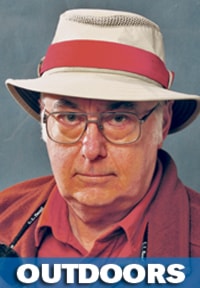Twenty-two years ago, Darryl Smith, dentist, outdoorsman and environmental activist from Valleyview, in Northern Alberta, took me on a fishing tour of his Little Smoky River; “his” because the doctor was the father of the Little Smoky becoming the first designated catch and release grayling fishery in North America.
Darryl wanted to show me his favourite, largely untracked back country stretches of the river, so we travelled on two ATVs, what I was calling “Kamikaze 500s,” “phoney ponies,” and “tin horses” in those days. Part way in, Darryl’s heavily loaded “horse,” climbing out of a berm, did a back flip over on him that scored 9.5 … on the Richter scale.
Weirdly and waggishly I thought of uttering the Wayne and Shuster classic line “Is there a doctor in the horse?” into the sudden silence and mushroom dust cloud. But then I remembered the only person who knew the way back out to civilization was buried under the dog pile of Kamikaze 500, gear, grub, fishing and camping equipment.
But Darryl badgered out from under, miraculously uninjured and unfazed. That is the man I have known forever, calm and steady, although, since he has been fish chairman for the Alberta Fish and Game Association, I detect an occasional smidgen of angst and anger at the Alberta government’s total abdication of all responsibility for fisheries protection and management in favour of ignoring anglers except for abusing, and misusing them.
So I was quite unprepared for the anxious tone of Smith in his report on his mid-September tour with Encana Corp. of some of their oil and gas operations sites near his Vallyview home area.
“To say I was overwhelmed would be an understatement,” Darryl commences, and then gets on with what bothered him about what he was being shown.
“I saw double drilling rigs (transformers would be a better term),” Darryl says, able to move themselves across a well site in less than 12 hours to begin another hole (10 to 12 holes on every lease). … The actual drilling time for each hole has been reduced from 61 days to 30. Once the rigs move off the lease site to another one, then the fracking process begins.
“For fracking, each hole requires 30,000 to 50,000 cubic metres of water!
“To put that in perspective, a 12-pad well site would use two-thirds of the annual water required for a town like Valleyview (pop. 2,000).
“The associated water reservoir on the site we saw most of is one of 13 to be built by Encana alone and holds 375,000 cubic metres, not likely enough to complete the frack for this site alone.”
One reason for Darryl’s shock is that the water is taken from his beloved Little Smoky River, one of Alberta’s few remaining angling treasures.
Smith’s concerns mirror some of my own regarding a huge tract of public land dozed flat next door to a quarter section of my own to horizontally drill under my land. There, the fracking water will be taken from my own home stream, Prairie Creek. I had wondered about the huge pile of logs on the lease.
Darryl Smith reports “trees are required to be salvaged, but forest companies often do not even bother to pick them up, and when that happens Environment Sustainable Resource Development requires that the salvaged and stored timber be placed on additionally cleared areas, further expanding the environmental footprint.”
Among Darryl’s concerns are the total lack of monitoring, particularly of the total amount of our pure fresh surface water being poisoned and pumped underground to extract more oil and gas, and his grave doubts that the surface damage will ever be reclaimed.
Coincidentally, I have been reading of the fatal collision course of the environment and big energy economics in Louisiana that has resulted in a chunk of the state as big as Prince Edward Island having sunk into the Gulf of Mexico, mostly caused by well-access canals dug by oil and gas developers.
We are on that same fatal head-on collision course in Alberta, but the result will not be the sinking of our land into the sea.
It is too often lost sight of that most of the great deserts on Earth were once lush, verdant forests until, among other factors, mindless, rapacious deforestation by human activities.
What we are doing in Alberta now sounds to me like a classic modern recipe for desert creation: clear cutting the headwaters of our watersheds, and lower down clearing huge public land lease sites for drilling small holes, poisoning and pumping unknown volumes of our finite amount of fresh water underground in the fracking process, never to surface or be seen again in any usable form for sustaining life; all this going on simultaneously and with the given of climate change and global warming.
Is there a doctor in the hearse?
Bob Scammell is an award-winning columnist who lives in Red Deer. He can be reached at bscam@telusplanet.net.
